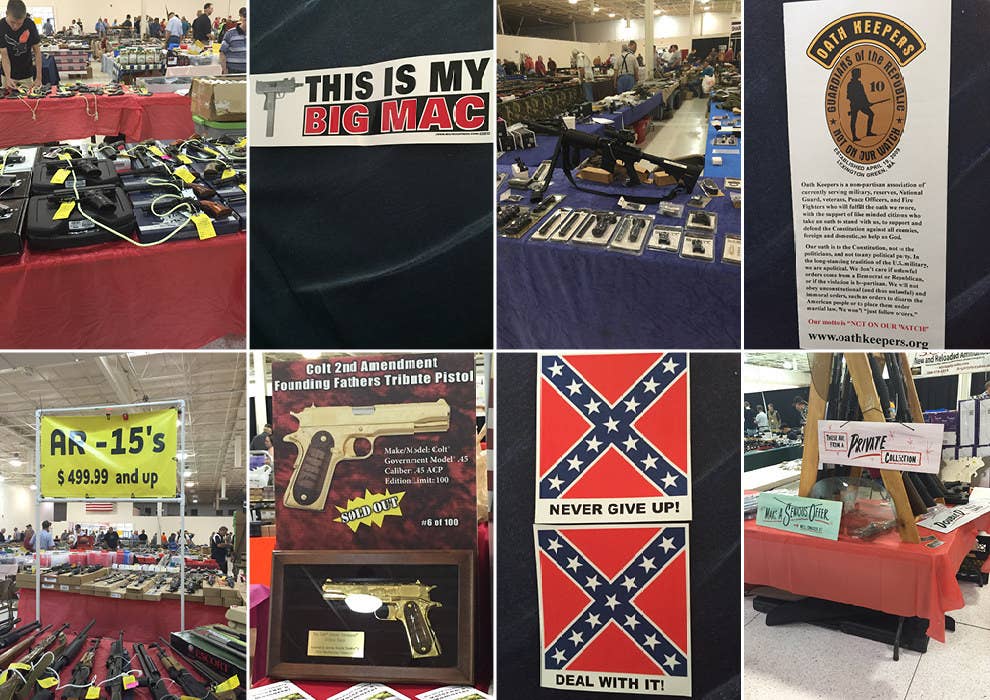
On the first Saturday morning in August, I stepped out of my car in a suburban Indiana parking lot and watched three middle-aged white men aim squinty-eyed suspicion at me from two spaces away. As a Wisconsin native, I’m used to squinty-eyed white Midwestern suspicion. But since we stood several hundred feet from a lot of guns and I figured the guys were probably armed, my feet froze. I had to drag myself to the entrance of the Kokomo Gun Show, where a brown-haired stocky white guy in his twenties talked to his friends while resting his elbow on a rifle butt as if leaning on a gun was the most natural posture imaginable.
I passed hundreds of parked cars on my way to the front door. This was a couple months after Dylann Roof was accused of killing nine people in a black church in Charleston, South Carolina, and a week after John Russell Hauser was accused of killing two and wounding nine in a movie theater in Lafayette, Louisiana. Gun purchases in America tend to spike after mass shootings and terrorist attacks, because such events heat up the gun control debate.
On this Black Friday — less than a month after the terrorist mass shooting in Paris — gun sales were projected to spike again. There were 50 gun shows listed across the country, and the FBI predicted that gun sellers would run a record 190,000 background checks in a 24-hour period — not that prospective buyers need to undergo a background check to buy guns from private vendors at the Kokomo Gun Show or those in dozens of other states including Florida, Texas, and Ohio.
But background checks are required in Illinois, where my teenage cousin joined a gang and shot someone in 2010. He took his lawyer’s advice not to talk about his case, so I channeled my sadness into learning how Chicago gangs like his get their guns. More of the guns used in Chicago gang shootings come from Indiana than anywhere else.
On paper, buying a gun in Indiana is extremely easy. Go to a gun show, decide on a gun from a seller’s private collection, hand over an Indiana ID and some cash, leave armed. But I didn’t think I, a black woman, would be welcome at a gun show.
Four people sat at the registration table: one white guy in his fifties and three women in their twenties, one of whom was black. Her blackness threw me off nearly as much as the mood outside. We made the sort of eye contact that meant we’d acknowledged each other’s blackness but we weren’t going to bond over it. I paid the $5 admission fee and told the guy, who called me sweetie, that since I didn’t have a gun I didn’t need to check mine while I shop. I turned away from him toward tables filled with more guns than I’d ever seen, forgot how to breathe, and retreated to the bathroom to calm myself behind a locked stall.
Americans like to use big tent metaphors to describe our political affiliations. We paint our values with broad strokes and then point to the many types of people on our side as evidence that we are open-minded, accepting, and correct. Pro-gun advocates are no exception: People in favor of lax gun laws say that since the majority of gun owners are law-abiding, reasonable people, we can overlook the bigots, the criminals, and the domestic terrorists like Robert Lewis Dear, who is accused of killing three people and injuring nine more at a Colorado Planned Parenthood on Black Friday. As long as the lone criminals are white.
Gun ownership is seen as an upstanding white person act.
Last spring, Cliven Bundy, a Nevada rancher trespassing on federal land, faced off with federal agents while armed and suffered no consequences. Same goes for the Oath Keepers, the militia that showed up heavily armed to Black Lives Matter protests in Ferguson over the summer, angering local law enforcement — though evidently not as much as unarmed, black Michael Brown. The previous year, John Crawford, III, 22, and Tamir Rice, 12, were shot and killed by police while carrying toy guns in Ohio, an open-carry state. And in the past few years, other unarmed blacks have been killed for offenses such as selling hand-rolled cigarettes and asking for help after a car accident.
Black people aren’t part of the big tent of gun ownership. We’re never assumed to be law abiding, reasonable gun owners. That kind of gun ownership is seen as an upstanding white person act; a picket fence closed to outsiders like blacks. I wanted to see what was on the other side of the slats separating me from perfectly honorable, white people gun show attendance.
The exhibition hall was 27,000 square feet, or about half a football field. The lighting was fluorescent, the folding tables cheap, the guns sold alongside ammunition, knives, extra-strength flashlights, beef and turkey jerky, and lots of camo. There were plenty of private vendors standing behind signs that said Private Collection, Cash Only, No Questions Asked. One vendor tried to sell me one of his lovely retro guns, .38 specials with pearly stocks and long, tapered silver barrels that would look just right in a woman’s hand in a '60s art film. But most of the guns in the room were standard black handguns and rifles.
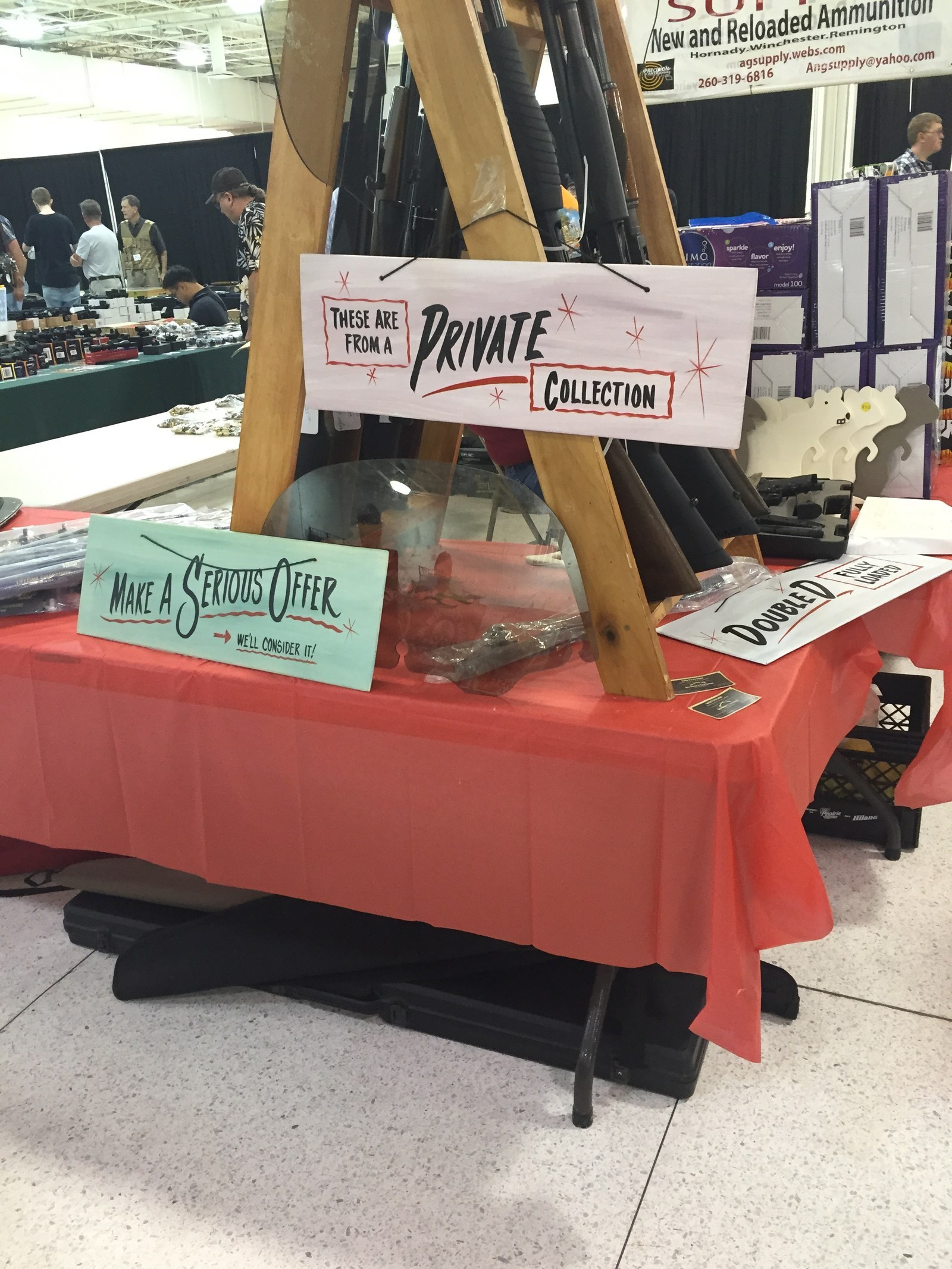
The room’s demographics: roughly 300 people total, overwhelmingly white guys in their forties to seventies. I saw three white female gun vendors, one South Asian male gun vendor, one black guy selling knives, one black woman selling guns, and one 10-year-old black kid scanning the tables with his white dad. This was a lot more diversity than I expected, but not enough to stop people from staring at me.
“I don’t want to know what it’s like to use them.”
The first person who seemed happy to see me was a biracial female gun vendor who asked me not to print her name. G is 45 years old, half black, half white, and works part-time at a gym. She didn’t often see black people at shows like this, and she was eager to talk about the racial demographics of gun shows. The atmosphere is “conservative,” she told me, and “can feel unwelcoming sometimes.”
Growing up in Indianapolis, G didn’t see the need for guns. Then she moved to Kokomo, less than an hour outside the city, and met her white fiancée. He educated her "on guns and why they’re useful,” and manned the table across the aisle from us. She owns guns, practices shooting them at a nearby range, and keeps them around for protection. “I don’t want to know what it’s like to use them,” she told me. “I’d rather not know. I need the information, but I don’t want to use it.”
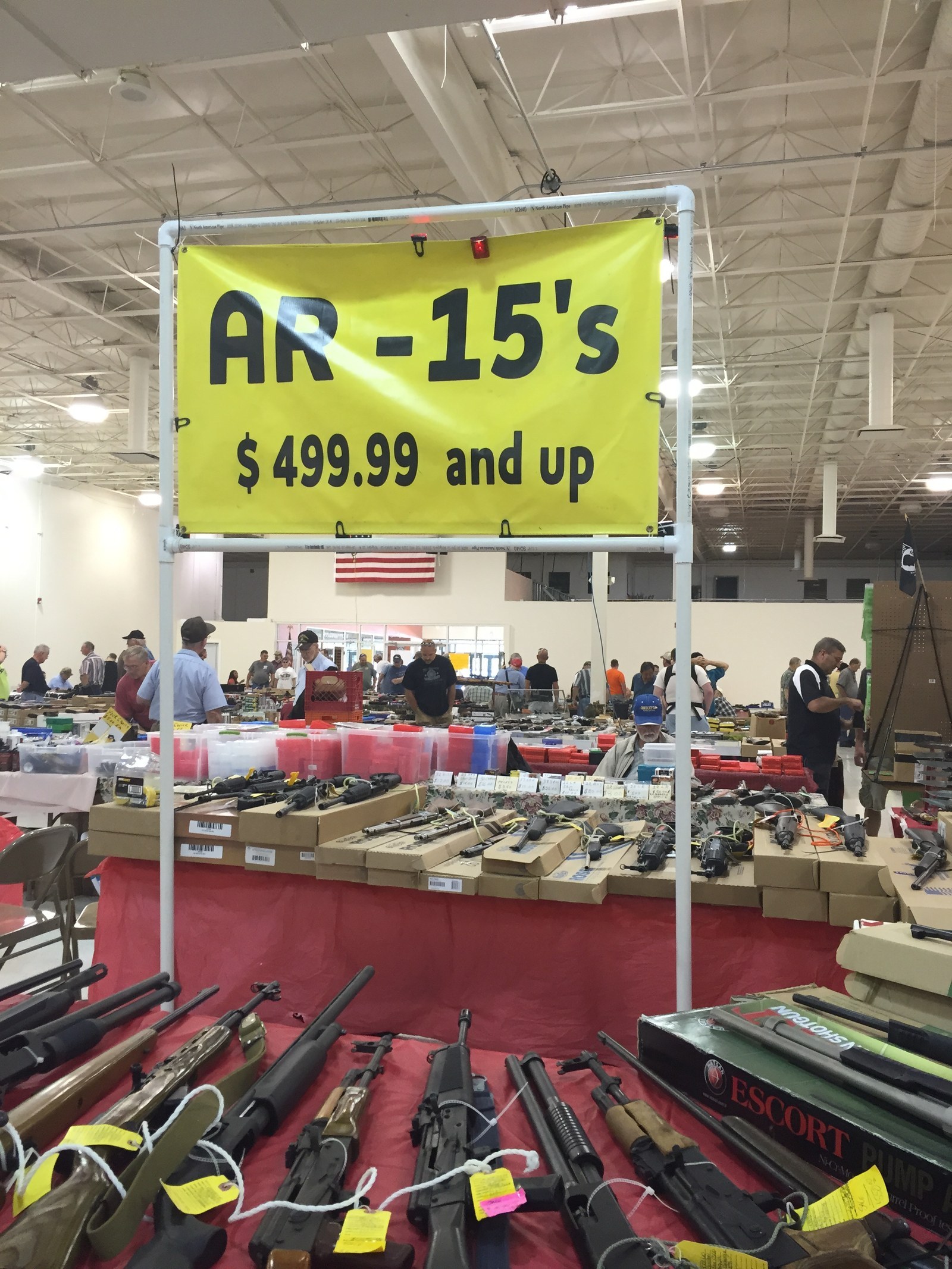
I took another lap around the show. The most charitable way to describe the mood was quiet. Gun shoppers are not a talkative group. White men looked at me with cut eyes and pinched mouths, but also at each other. I saw one guy wearing a T-shirt that said It’s Not Racist If It’s True, and looked back at G from halfway across the room. She seemed perfectly comfortable sitting behind her table, and I ached for her anyway, having to see T-shirts like that at shows like this.
I met one friendly white guy, Scott. He said he sells a lot of guns to black women in Ohio and gushed to me about the AR-15. He picked one up, put the gun’s butt on his chin and told me that thanks to its lack of recoil he could fire it in that position if he wanted. I knew I was supposed to get excited about a gun I could fire from my face, so I added some oomph to my smile. He recommended a nearby brewery for lunch. Then I made eye contact with another round of flinty white men and re-entered the malaise that gripped the entire room.
My black dad is a sincere supporter of the Second Amendment. He owns two rifles and two handguns. The rifles are for deer hunting, a typical Wisconsinite passion. The handguns are for home defense. I grew up in Madison, Wisconsin, a roughly 250,000-person university town, where it was not uncommon for my high school classmates to miss an extra day or two around Thanksgiving to hunt deer. I enjoy venison, especially when cooked in butter. I do not own a gun, but I could.
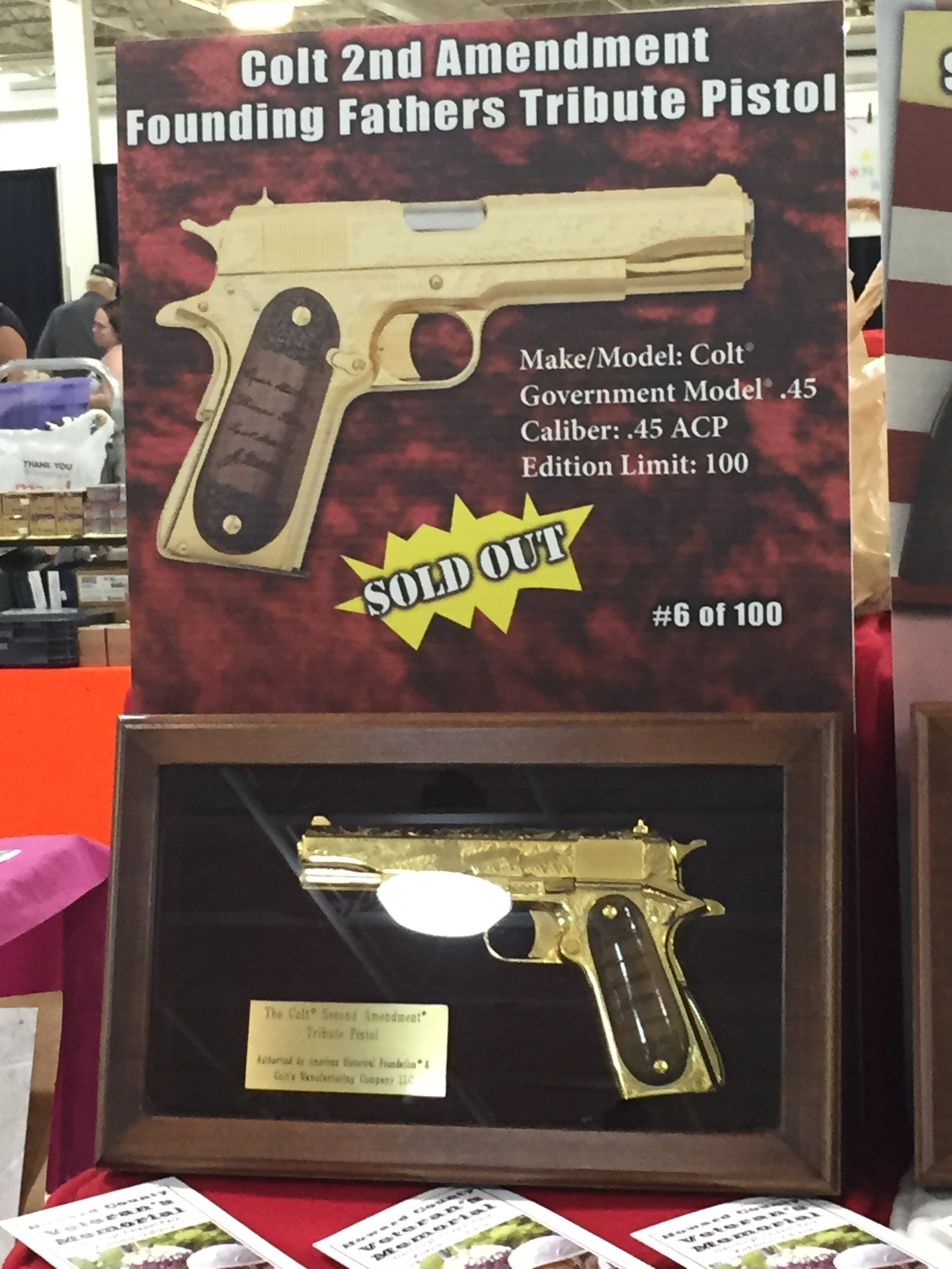
I’m equally familiar with the uniquely white Midwestern combination of down-home friendliness and suspicion that I encountered at the gun show, in alternating rounds. It’s subtle, but it’s constant, and I felt it for the 23 years I lived there. Sometimes it bubbled into something more, like the fourth grader who called me a nigger at school. But mostly it was the high school and college friends who told me I “wasn’t that black,” and confided in me about their love lives and career dreams. It’s the dizzying swing from Scott and his lunch recommendations to the men who stare at me as if blinking might physically wound them.
It was a 25-year-old woman named Sarah’s job to collect the entry fee and make sure people didn’t steal the guns, which she told me they try to do “all the time.” Sarah didn’t own any guns herself, but she shot friends’ guns in their backyards. Earlier I asked Scott where he shot his guns and he said the same thing: in his backyard. I imagined entire Midwestern towns of people wandering out the back door on summer days to aim bullets into dirt.
Ask white suspicion what it’s afraid of and it smiles frantically.
Later it occurred to me what was missing from this picture: the kind of hunting culture that indicates people plan to shoot something other than each other. There was no mention of deer, or skeet, or fun, or even a significant profit. Scott said he only brings in $40 or $50 a gun. All I found was a vague, room-wide fear that explains how G can be into guns and not want to have to use her guns. The gun show is where that white suspicion arms itself.
Again, my dad’s a home invasion guy, so I kind of understand their fear. And yet I don’t. Ask white suspicion what it’s afraid of and it smiles frantically. It evades the question, and it doubles down on its right to be white, suspicious, and armed. One gun show table held pamphlets for the Oath Keepers, the non-partisan militia whose mission is to protect Americans from being disarmed — using assault rifles. But what it feels like people are most suspicious of is me.
I turned a corner and found an overweight man in his sixties with a thin halo of hair and suspenders holding up his jeans behind a table full of bumper stickers. Confederate flags screamed redly among the black and white right-wing slogans. Here, in the Union state of Indiana, which outlawed slavery in 1820, gun owners embrace the national symbol for being willing to go to war for your right to abuse black people.
“Never Give Up!” one said.
“Deal With It!” said the other.
Looking at those stickers was like being slapped in the face.
I stood there paralyzed long enough to give the impression that I was seriously considering buying something. When I realized that I feared the guy sitting behind the table too much to whip out my phone and photograph the stickers on the spot, I bought one of each so I could take my pictures at home.
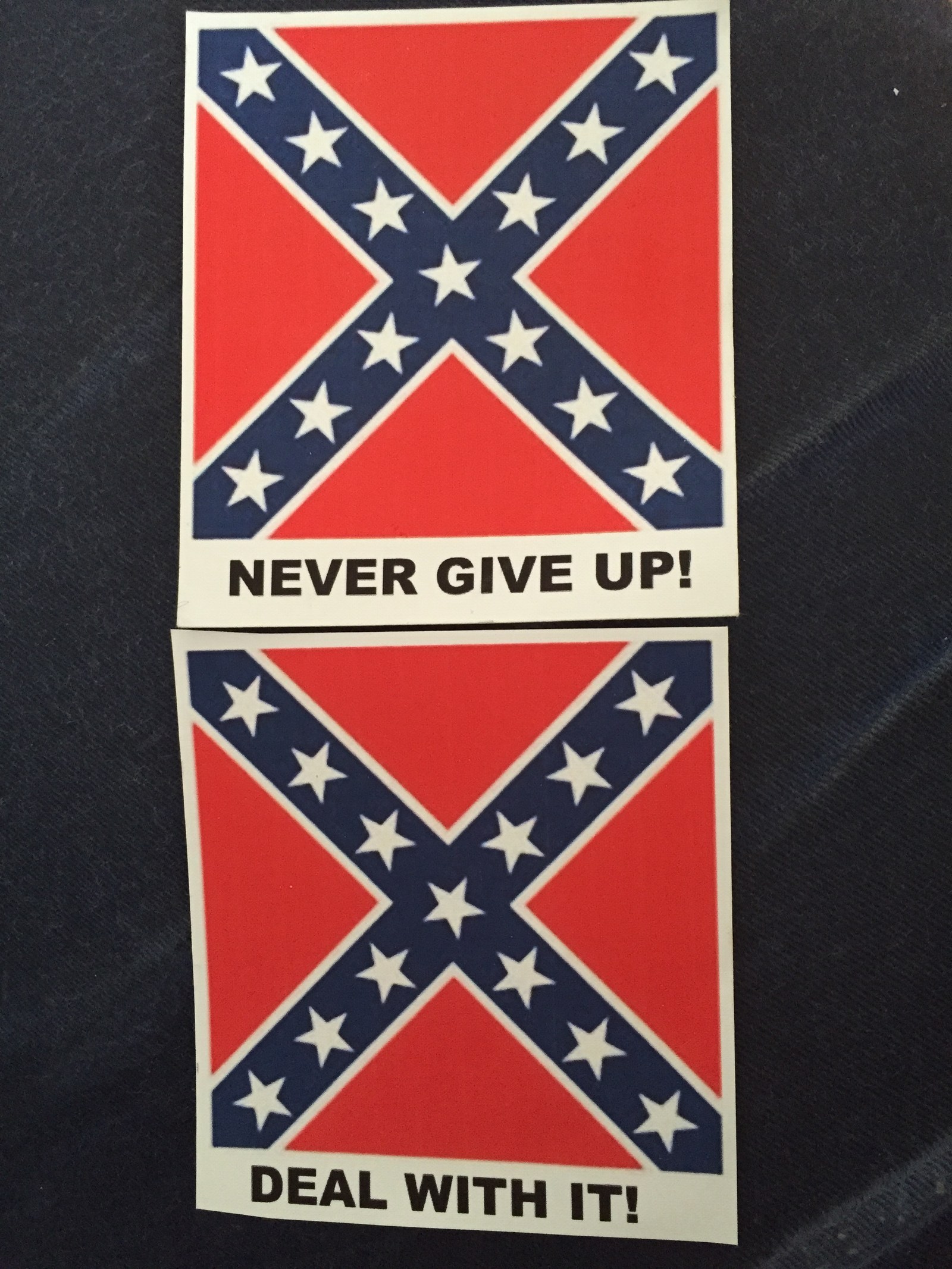
I attempted to give off an “I am a badass for standing here and buying your Confederate flags even though you hate me” vibe. But I doubt it covered the nervousness that made my armpit sweat pour down like rain. The vendor didn’t care to make eye contact with me, even when I handed over my $3. He furtively put the cash in his pocket and found a wall to contemplate with great passion.
I stared down hate and it wasn’t worth it. The transaction ended quickly and not soon enough.
In defiance of Confederate flag number one, I gave up. I walked outside and took my first deep breath in hours. But the calm that settled over me upon leaving the gun show disappeared when I remembered the flags in my purse. I was disgusted at myself for giving $3 to a man who despised me, a feeling that made my hands shake on the wheel. For the entire 700-plus mile drive home I never took more than five minutes’ rest from cursing myself for donating money to the Confederate flag cause.
